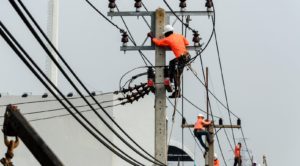Electrical Safety Meeting Kit

ELECTRICITY BASICS
Electricity flows more easily through some materials than others. Some substances such as metals generally offer very little resistance to the flow of electric current and are called ” conductors.” A common but perhaps overlooked conductor is the surface or subsurface of the earth. Glass, plastic, porcelain, clay, pottery, dry wood, and similar substances generally slow or stop the flow of electricity. They are called ” insulators.” Even air, normally an insulator, can become a conductor, as occurs during an arc or lightning stroke.
HAZARDS / DANGERS
Hazards / Dangers associated with electricity affect the majority of workplaces. In general industry, construction, or farming electrical hazards / dangers are present. The task is to have the ability to identify and recognize electrical hazards around you and then to reduce / mitigate and eliminate them.
Common Electrical Hazards
- Overhead powerlines
- Underground powerlines
- Lightning
- Faulty equipment
- Working on energized equipment
- Improper grounding
- Damaged insulation
ELECTRICAL – INJURIES
There Are Four Main Types of Injuries That Can Result from Electrical Currents:
Electrocution, electric shock, burns and falls when a worker contacts electrical energy.
CAUSES OF ELECTRICAL SHOCKS
Electricity travels in closed circuits, normally through a conductor. But sometimes a person’s body—an efficient conductor of electricity—mistakenly becomes part of the electric circuit. This can cause an electrical shock. Shocks occur when a person’s body completes the current path with:
- Both wires of an electric circuit
- One wire of an energized circuit and the ground
- A metal part that accidentally becomes energized
- Another “conductor” that is carrying a current
HOW CAN WORKERS TELL IF A SHOCK IS SERIOUS?
A severe shock can cause considerably more damage than meets the eye. A victim may suffer internal hemorrhages and destruction of tissues, nerves, and muscles that aren’t readily visible. Renal damage also can occur. If an employee receives a shock, he or she should seek emergency medical help immediately.
WHAT KIND OF BURNS CAN A SHOCK CAUSE?
Burns are the most common shock-related injury. An electrical accident can result in an electrical burn, arc burn, thermal contact burn, or a combination of burns.
- Electrical burns are among the most serious burns and require immediate medical attention. They occur when electric current flows through tissues or bone, generating heat that causes tissue damage.
- Arc or flash burns result from high temperatures caused by an electric arc or explosion near the body. These burns should be treated promptly.
- Thermal contact burns are caused when the skin touches hot surfaces of overheated electric conductors, conduits, or other energized equipment. Thermal burns also can be caused when clothing catches on fire, as may occur when an electric arc is produced.
GENERAL SAFETY TIPS FOR WORKING WITH OR NEAR ELECTRICITY.
- Don’t stand in wet areas when using electrical tools.
- Inspect cords for damage or wear prior to each use.
- Unplug machinery, power tools and appliances before cleaning, inspecting, repairing or removing something from them.
- When unplugging a cord from an outlet, pull on the plug, not the cord. Pulling on the cord causes wear and may lead to a shock.
- If outlets or switches feel unusually warm, don’t use them and get a qualified electrician to check the wiring.
- Plug power tools into grounded outlets installed with Ground Fault Circuit Interrupters.
- If it’s necessary to affix cords to a wall or floor, use tape. Nails and staples can damage cords and cause fire and shock hazards.
- Don’t tie power cords in a knot, as knots can cause short circuits and shocks. Instead, loop the cords or use a twist lock plug.
- When working outdoors, watch for overhead power lines and buried power line indicators. Always assume overhead power lines are energized and stay at least 10 feet (3 meters) away from them.
- Use “C” rated extinguishers for electrical fires. Never use water.
ELECTRICAL “GROUND” RULES
- The risk of shock or electrocution is greatest around metal objects and in damp conditions.
- Keep your electrical system in good operating condition.
- Make sure you and other workers follow lockout and tagout procedures.
- Contact with overhead power supply lines is a frequent electrical-related killer.
FINAL WORD
There are many different electrical hazards in any one workplace. It is important to understand electrical safety and respect the dangers electricity poses. Eliminate any electrical hazards in your work area to avoid an injury to yourself or another coworker.